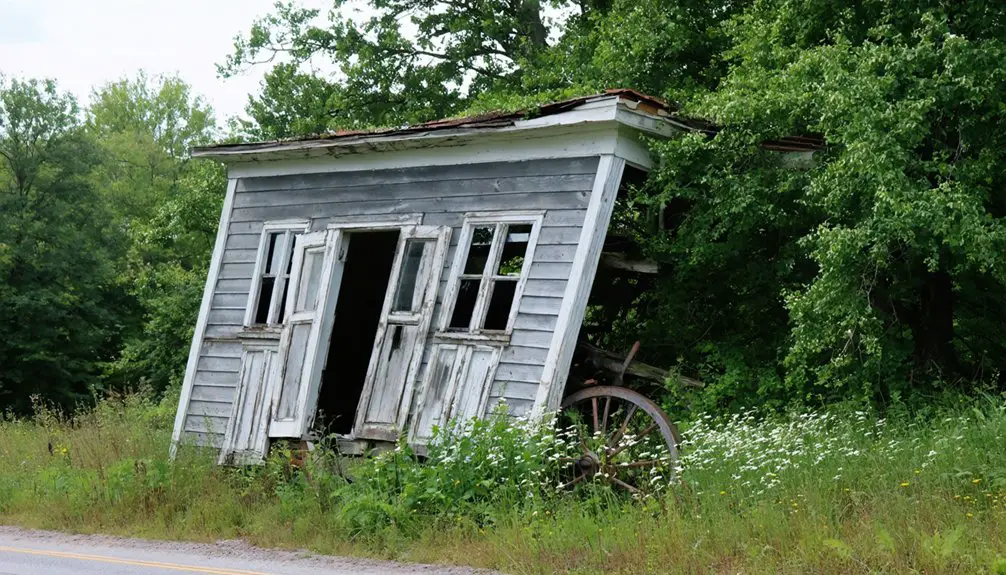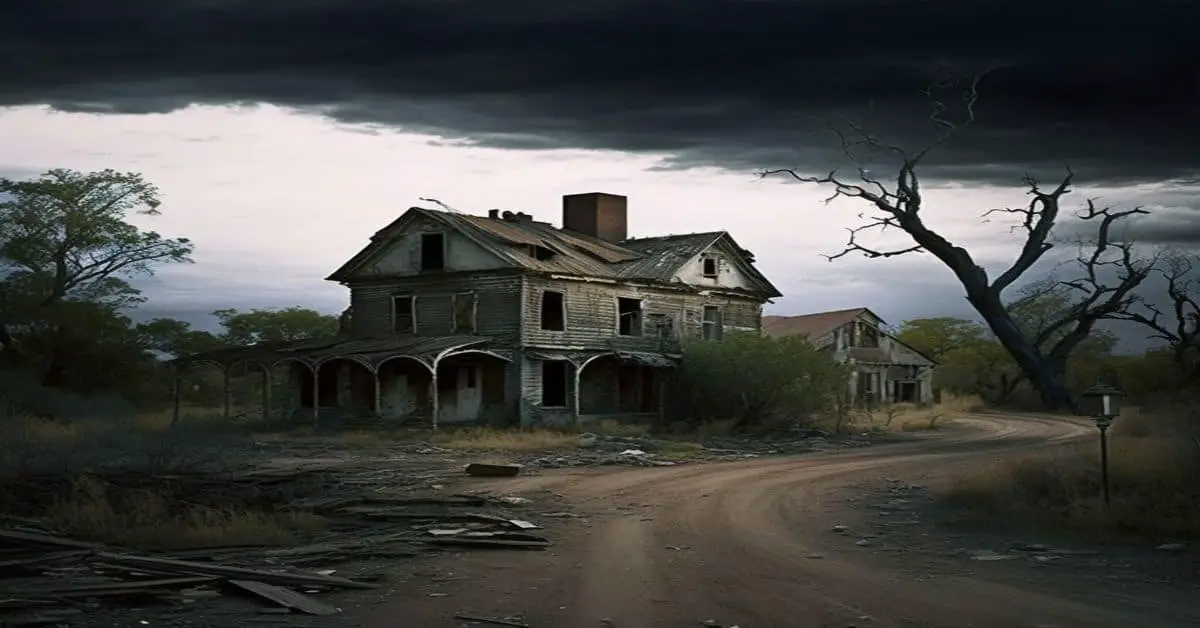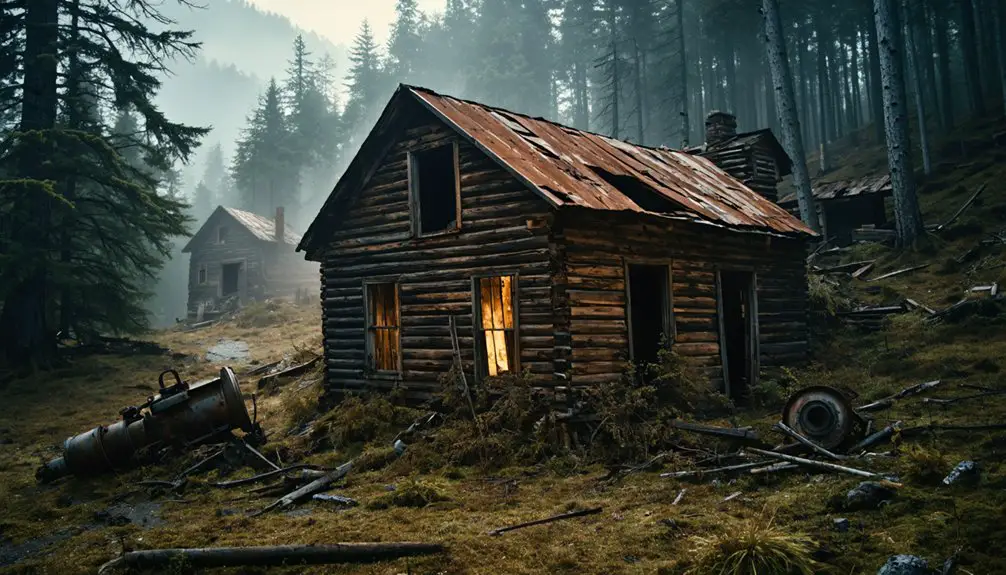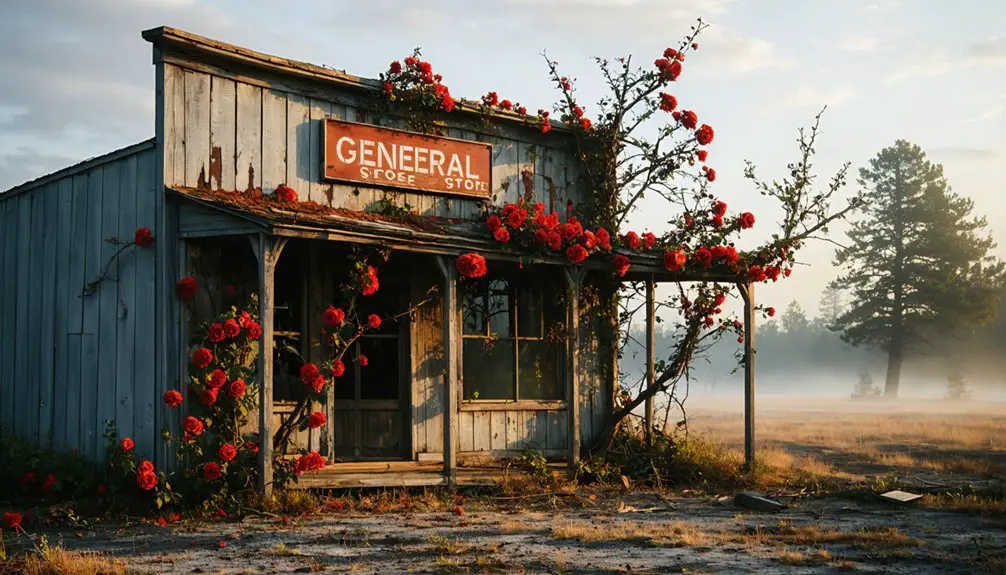You’ll find Kendall’s remnants along Maryland’s Youghiogheny River, where a thriving lumber town operated in the early 1900s. Originally called Yough Manor, then Krug, the settlement reached its peak under the Kendall Lumber Company, producing 3.5 million board feet monthly with nearly 1,000 workers. After timber depletion led to the company’s collapse in 1912, the town gradually emptied. Today, crumbling foundations and industrial relics tell a compelling story of Appalachian boom-and-bust economics.
Key Takeaways
- Kendall was a thriving lumber town in Maryland that became abandoned in the 1920s after the collapse of its timber industry.
- At its peak, the Kendall Lumber Company produced 3.5 million board feet of lumber monthly and employed nearly 1,000 workers.
- The town’s infrastructure included narrow gauge railways, a company store using scrip currency, and housing for lumber workers.
- The site now contains crumbling foundations, roofless structures, and industrial relics as evidence of its former existence.
- Historical markers along nature trails guide visitors through the ghost town’s remains, preserving Maryland’s industrial heritage.
The Three Names of a Forgotten Town
While many ghost towns fade into history with a single identity, the abandoned settlement now known as Kendall, Maryland cycled through three distinct names during its brief existence.
The Yough Manor origins began in 1889 when the Yough Manor Lumber Company established a sawmill and basic infrastructure along the Youghiogheny River.
You’ll find the town’s next chapter marked by the Krug expansion in 1891, when A. Knapp Company arrived and renamed the settlement after Henry Krug, their company official.
The final transformation came in the early 1900s when Kendall Lumber Company took control, giving the town its lasting identity. To avoid confusion with other locations sharing the name, historical records often include a disambiguation page for Kendall. The company operated its own transportation system with a private railroad that connected multiple Maryland towns.
Each name change reflected the shifting corporate ownership that defined this logging community until its abandonment in the 1920s.
Life Along the Youghiogheny River
Nestled between steep canyon walls and the rushing Youghiogheny River, Kendall’s geography played a decisive role in shaping life along this vital waterway.
You’d find lumber mills humming with activity, shipping over 3.5 million board feet of timber daily in the early 1900s. The river’s numerous waterfalls made traditional log rafting impossible, so narrow-gauge railroads snaked through the valley, connecting communities from Friendsville to Sang Run. Krug Stave Mill, established in 1891, marked a significant industrial development in the area.
You could’ve joined the locals for Sunday train excursions up the Youghiogheny River, picnicking alongside B&O Railroad officials who hunted and relaxed at the town’s log Clubhouse.
These community connections flourished briefly, powered by the convergence of timber, coal, and agricultural industries, until operations ceased in 1912. Today, the river is protected under the Maryland Wild and Scenic Rivers Act, ensuring its natural beauty for future generations.
Golden Age of Lumber Operations
During Kendall Lumber Company’s peak years, you’d have witnessed an impressive 3.5 million board feet of lumber shipped monthly through their expanding network of mills and rail lines.
You’d have found the latest sawmill technology operating at full capacity, powered by both steam engines and the rushing waters of the Youghiogheny River.
Looking across the bustling mill yards, you’d have seen nearly 1,000 workers managing the daily operations, from felling trees in remote hollows to loading finished lumber onto railcars bound for distant markets.
Peak Production Years
At the height of its operations, the Kendall Lumber Company established itself as a major force in Maryland’s timber industry, shipping an impressive 3.5 million board feet of lumber monthly from its Garrett County facilities.
You’ll find that despite these high shipment volumes, lumber production challenges constantly plagued the company, forcing them to halt new contracts due to chronic shortfalls.
The operation’s success relied heavily on old-growth Appalachian hardwoods, though they also harvested less profitable hemlock from the Youghiogheny Valley.
Forest sustainability issues became apparent as the myth of superabundance led to aggressive overharvesting.
Maryland’s timber harvest exceeded sustainable growth by 30%, and by the 1910s, forest depletion was undeniable.
This unsustainable practice ultimately forced Kendall Lumber Company’s collapse by 1912, marking the end of its peak production years.
Mill Technology Advances
The technological evolution of Kendall’s lumber operations marked a transformative period in Maryland’s timber industry, beginning with the Yough Manor Lumber Company’s pioneering sawmill in 1889.
You’ll find that sawmill innovations rapidly transformed the landscape as A. Knapp Company introduced specialized stave mill technology by 1891, diversifying production capabilities beyond basic lumber processing.
The introduction of steam power revolutionized operations, replacing earlier manual methods and enabling unprecedented output.
Kendall Lumber Company’s advanced machinery could process an impressive 3.5 million board feet daily at its peak.
The mill’s efficiency was bolstered by an intricate network of narrow gauge rail lines that penetrated deep into remote forest areas, while strategic bridge construction at sites like White Rock enhanced access to timber resources upstream.
Workers’ Daily Operations
While Kendall’s lumber industry reached its zenith in the early 1900s, nearly 1,000 workers filled diverse roles across Garrett County’s sprawling timber operations.
You’d find strong worker camaraderie among crews who mastered logging techniques using crosscut saws, axes, and peaveys to harvest old-growth Appalachian forests.
Daily life centered around three essential aspects:
- Dawn-to-dusk shifts following seasonal patterns
- Coordinated teamwork for felling, limbing, and loading massive logs onto rail cars
- Living in company housing near mills and railroad tracks
Workers earned their pay through physical endurance and skilled craftsmanship, from sawmill operations to barrel stave making.
When Sunday came, you’d spot them taking leisure rides on trains from Friendsville or gathering at the “Clubhouse” to unwind from their demanding work week.
Railroad’s Vital Role in Development

Originally established as Yough Manor in 1889, Kendall’s development hinged entirely on the Confluence-Oakland Railroad‘s extension upriver from Friendsville.
You’ll find that railroad engineering played a vital role, with narrow gauge tracks expertly maneuvering the rugged terrain and crossing the Youghiogheny River at strategic points like White Rock and Salt Block Run.
The railroad revolutionized logging transportation, enabling the shipment of 3.5 million board feet of lumber daily at its peak. The company’s 16-ton Gilbert locomotive was a unique asset to their operations.
When A. Knapp Company set up their stave mill in 1891, the town was renamed Krug.
By 1909, Kendall Lumber Company had taken over, expanding operations upstream.
The rail system’s temporary spurs reached deep into logging territories near National Falls, Sang Run, and Swallow Falls, transforming this remote area into a thriving lumber hub. Like many Maryland logging operations, the railroad system utilized three-foot gauge tracks for efficient timber transport.
Daily Life in a Company Town
Living in Kendall meant existing within a tightly controlled company ecosystem, where nearly every aspect of daily life revolved around the lumber operation’s schedule and needs.
Community dynamics centered on the mill’s daily rhythm, with families sharing common experiences that fostered social cohesion despite the constraints of company control.
You’d find your daily routine structured around:
- Working long hours at the mill or logging operations, handling an impressive 3.5 million board feet of lumber daily
- Shopping at the company store using scrip instead of real currency
- Participating in Sunday church services and leisure activities, including popular picnics and gatherings at the Clubhouse
Your housing, education, and social interactions all fell under the company’s influence, creating a close-knit but dependent community between the Youghiogheny River and canyon walls.
Notable Landmarks and Buildings
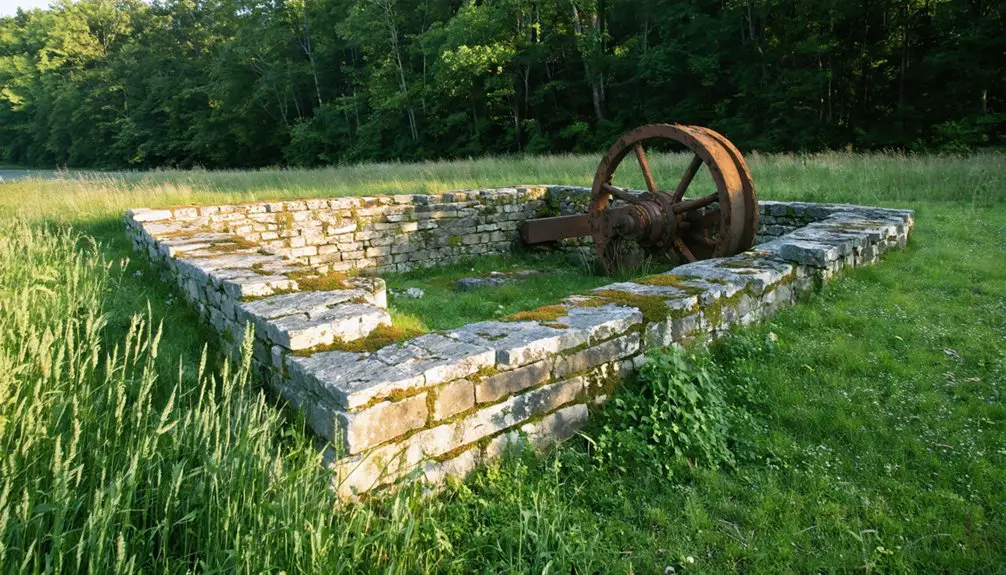
Beyond the daily routines that defined life in Kendall, the physical structures themselves told a compelling story of industrial ambition and company-planned development.
You’ll find the historic structures centered around the sawmill complex, where railroad-connected facilities once processed Appalachian old-growth timber. The industrial remnants include deteriorating mill buildings, scattered foundation stones, and traces of railroad infrastructure like trestles spanning the Youghiogheny River. Much like the abandoned Klotz mill in Lonaconing, these structures serve as a time capsule of American manufacturing history.
Worker housing and community buildings were strategically placed around the mill and rail lines in a classic company town layout. Visitors have reported hearing the sounds of phantom gunfire echoing through the abandoned structures, similar to experiences at other historic Maryland sites.
While most structures have succumbed to time, you can still spot remnants of modest wooden homes, early 20th-century vacation cottages, and the shells of general stores.
The surrounding forest has largely reclaimed these sites, with nature steadily erasing Kendall’s industrial footprint.
Peak Years of Industrial Success
During its industrial peak in the early 1900s, Kendall emerged as one of Maryland’s most productive lumber towns after the Kendall Lumber Company acquired and expanded the original mill operations.
The company’s advanced logging techniques and strategic rail networks helped achieve staggering production numbers, with daily shipments reaching 3.5 million board feet of lumber.
The bustling industrial center supported:
- Nearly 1,000 lumber industry workers across Garrett County
- Weekend community events drawing Friendsville residents by train for post-church picnics
- A thriving service economy with homes, schools, and businesses
The town’s social life centered around the “Clubhouse,” where B&O railroad officials entertained guests in a rustic log retreat.
You’d find narrow gauge railways stretching into remote hollows, ensuring a steady flow of timber to feed the mill’s voracious appetite.
The Slow Fade Into History

When you visit Kendall today, you’ll find only crumbling foundations and roofless structures that echo the town’s industrial peak, with nature steadily reclaiming what humans left behind.
Located in Garrett County, this former logging settlement stands as a testament to Maryland’s industrial heritage.
The exodus of residents began immediately after the 1912 timber industry collapse, as families sought work elsewhere, leaving their homes and businesses to deteriorate.
Abandoned Structures Tell Stories
The crumbling foundations and scattered industrial remnants of Kendall tell a poignant story of boom-and-bust economics in early 20th-century Appalachia.
As you explore this ghost town‘s urban decay, you’ll find historical markers along nature trails that guide you through what was once a thriving lumber hub.
Three key features reveal Kendall’s industrial past:
- Narrow gauge railway remnants that transported 3.5 million board feet of timber daily
- Mill foundations now partially submerged beneath Yough Lake’s waters
- Historic industrial relics framed by dramatic canyon walls and the Youghiogheny River
The site’s historical preservation efforts focus on documentation rather than restoration, leaving these ruins as silent witnesses to the vulnerable nature of extraction-based economies and the communities they supported.
Population Exodus Timeline
Like many resource-dependent settlements of its era, Kendall’s population followed a predictable pattern of rapid growth and gradual decline that spanned just over three decades.
The population reached its peak of 1,500 residents by 1910 before beginning its descent.
You’ll find the town’s demographic shift directly tied to timber depletion, beginning around 1912 when the old-growth forests could no longer sustain industrial-scale logging.
The community displacement accelerated after 1921 when the Barnes King Mine closed, eliminating another vital source of employment.
By the mid-1920s, you’d have witnessed families steadily departing as jobs vanished and businesses shuttered their doors.
The final chapter came in 1942 with the removal of the railroad tracks – Kendall’s last lifeline to the outside world.
What remained was quickly reclaimed by the same forests that had once fueled the town’s prosperity.
Legacy in Maryland’s Appalachian Heritage
As a tribute to Maryland’s industrial heritage, Kendall’s legacy endures through its profound influence on Appalachian development and identity. The ghost town’s remains tell a powerful story of logging culture, community dynamics, and the fierce spirit of independence that defined frontier industrial towns.
You’ll discover Kendall’s lasting impact through these key elements:
- The town transformed Maryland’s timber industry by processing 3.5 million board feet daily, showcasing Appalachian industrial might.
- Its innovative rail system revolutionized resource transportation in challenging mountain terrain.
- The “Clubhouse” established social patterns that shaped regional community gathering traditions.
Today, you can explore Kendall’s foundational ruins, which serve as a representation of the resilient spirit of Appalachian communities and their adaptability in the face of economic change.
Frequently Asked Questions
What Was the Average Wage of Lumber Workers in Kendall?
You’d find lumber industry workers in Kendall likely earned around 36 cents hourly, or $20.28 weekly, based on the economic impact of regional wage patterns common across Maryland’s timber operations in 1930.
Are There Any Remaining Descendants of Original Kendall Residents Today?
Like scattered leaves from a fallen tree, you’ll find no confirmed living descendants with direct connections to Kendall’s original residents. Historical records and archival research haven’t established definitive descendant connections today.
What Natural Disasters or Accidents Occurred During Kendall’s Operational Years?
Historical records don’t show any significant flood damage or fire incidents during Kendall’s operations. While the river location posed flooding risks and logging carried accident hazards, no major disasters are documented.
Can Visitors Legally Explore the Ghost Town Site Today?
You can legally explore the site via the public Kendall Trail without special exploration permits or ghost town regulations. Just exercise caution on rugged terrain and respect environmental preservation guidelines.
What Native American Tribes Originally Inhabited the Kendall Area?
To sum it up, you’d find the Piscataway, Chaptico, and Nacotchtank tribes called this area home. Their tribal history dates back centuries, with deep cultural significance along Maryland’s waterways and coastal regions.
References
- https://en.wikipedia.org/wiki/Kendall
- https://historyoftheupperyough.com/stories/kendall/
- https://www.novanumismatics.com/the-kendall-lumber-company-of-garrett-county-maryland/
- https://www.instagram.com/p/CwNm2Wqs2fW/?hl=en
- https://kids.kiddle.co/List_of_ghost_towns_in_Maryland
- https://friendsville.org/historytour/?page_id=306
- https://centralmontana.com/blog/visiting-the-ghost-town-of-kendall-in-central-montana/
- https://en.wikipedia.org/wiki/Youghiogheny_Scenic_&_Wild_River
- https://wildful.wordpress.com/2020/06/23/56-the-mighty-youghiogheny-river-scenic-and-wild/
- https://pagenweb.org/~somerset/bios/Kendall.pdf
